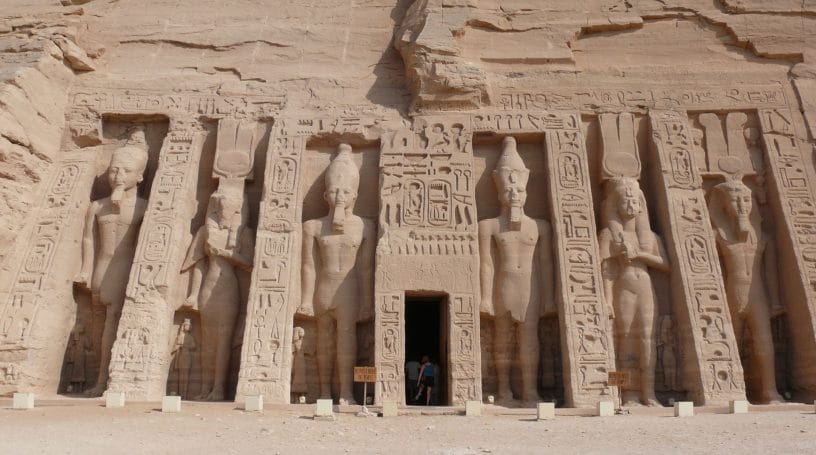Hey there, history buffs and adventure seekers! Let’s go on a virtual tour of Abu Simbel Temple, a mind-blowing creation from ancient Egypt. This colossal masterpiece is like a time capsule, transporting us back to a world of pharaohs and gods. Get ready to dig into its intriguing story, check out those epic carvings, and find out how it’s survived all these centuries. From hieroglyphic secrets to architectural wonders, we’ll unlock the mysteries of this iconic landmark. So, sit back, relax, and prepare to be amazed as we uncover fascinating facts about Abu Simbel Temple, a true testament to the incredible skill and imagination of our ancient ancestors.
Facts about Abu Simbel Temple
Imagine this: massive temples carved right out of sheer sandstone cliffs. That’s Abu Simbel! These aren’t just any temples, though. They’re a testament to the architectural genius of ancient Egypt and pack a whole lot of history within their colossal walls.
One of the coolest things? The temples were originally in a different spot! When a new dam threatened to flood their original location in the 1960s, engineers pulled off an incredible feat. They carefully took the temples apart, moving those gigantic statues and all, and rebuilt them on higher ground. Talk about dedication! This massive project, which ultimately saved Abu Simbel from being submerged by the rising waters of Lake Nasser, earned it a well-deserved spot on the UNESCO World Heritage list.
The temples were commissioned by the pharaoh Ramses II, a prominent figure in ancient Egyptian history. His legacy is literally carved into Abu Simbel, specifically the Great Temple, which he dedicated to himself (as pharaohs often did!), boasting about his victories in battle and honoring the gods. Just picture it: you walk in, and there he is, immortalized in stone statues towering over 60 feet tall!
But it’s not just about Ramses. Right next door, you’ll find the Small Temple, dedicated to Nefertari, Ramses II’s favorite wife. It’s pretty special, as temples dedicated solely to queens weren’t super common back in the day. This suggests just how much Ramses II cherished her. In fact, the Small Temple is only the second known instance in ancient Egypt where an entire temple was dedicated to a royal wife.
Walking through Abu Simbel is like taking a trip back in time. You’ll be blown away by the intricate carvings decorating the walls, each one telling a story. From the colossal statues guarding the entrance to the hidden chambers inside, every detail whispers of the power and artistry of ancient Egypt.
Even after centuries of enduring the elements – scorching sun, desert winds, even the occasional earthquake – Abu Simbel still stands strong. It’s a powerful symbol of resilience and a reminder of the incredible things humans can achieve. So, if you ever get the chance to visit, don’t miss it! It’s an experience you won’t soon forget.
What are 5 facts about Abu Simbel?
We’ve already touched on some of the wonders of Abu Simbel, but let’s dive a little deeper into what makes this place so special.
- Architectural Prowess: Imagine two massive temples, carved directly into a giant sandstone cliff – that’s Abu Simbel! These temples, known as the Great Temple and the Small Temple, are like time capsules showcasing the incredible skills and artistry of the ancient Egyptians.
- Ramses II’s Monument: The Great Temple is dedicated to the pharaoh Ramses II, a larger-than-life figure in ancient Egyptian history. This pharaoh wasn’t exactly known for being modest, and the temple reflects that. Just picture this: four colossal statues of Ramses II himself, each standing a towering 67 feet tall, guarding the entrance! These massive figures were built to showcase his power and military achievements, basically announcing to the world that Ramses II was a pretty big deal.
- An Engineering Feat: Fast forward to the 1960s. The construction of the Aswan High Dam was a game-changer for Egypt, but it posed a huge threat to Abu Simbel. The rising waters of Lake Nasser, created by the dam, were about to swallow these ancient treasures. Can you imagine the history we would have lost? Thankfully, a team of brilliant engineers came up with a daring plan: they literally cut the temples into manageable blocks, moved them piece by piece, and reassembled them on higher ground. It was an incredible feat of engineering, ensuring that these architectural masterpieces could be enjoyed by generations to come.
- A Testament to Love: Don’t let the name fool you – the Small Temple is just as impressive as its larger counterpart. Dedicated to Nefertari, Ramses II’s beloved wife, the temple’s intricate reliefs offer a glimpse into their relationship. Nefertari wasn’t just a queen; she held the revered status of a goddess. The reliefs depict the royal couple together, showcasing both her importance and Ramses II’s devotion.
- A World Heritage Treasure: Today, Abu Simbel stands as a UNESCO World Heritage Site, a testament to its cultural and historical significance. Every year, people from all corners of the globe flock to marvel at its grandeur, proving that the legacy of ancient Egypt continues to inspire and amaze.
Why is the Abu Simbel Temple special?
The Abu Simbel Temple isn’t just another pile of old rocks – it’s a powerful reminder of ancient Egypt’s glory days. What makes it so special? Let’s dive in.
A Monumental Display: Picture this: four gigantic statues of Ramses II, each towering over 60 feet. These aren’t just stuck onto the temple; they’re carved directly into the mountainside, like the mountain itself is saying, “Yeah, Ramses was a big deal.” And these aren’t just blank faces staring into space. They’re covered in intricate details – every wrinkle, every bit of muscle carefully carved to make Ramses look like the god-king he believed himself to be.
More Than Meets the Eye: Speaking of details, the inside of the temple is just as impressive. Imagine walking through halls covered in colorful reliefs, like a giant comic book carved in stone. These aren’t just pretty pictures; they tell stories about Ramses’ victories in battle, his relationship with the gods, and basically how awesome his life was. It’s like getting a peek into the mind of a pharaoh, frozen in time for over 3,000 years.
The Genius of Alignment: But the Abu Simbel Temple isn’t just about showing off. Its location and design are incredibly clever. The ancient Egyptians were masters of using the sun, and they built this temple so that twice a year, on dates that were important to Ramses, the sunlight would shine directly into the inner sanctuary, illuminating the statues of the gods inside. It’s like the whole temple comes alive, reminding everyone of the power of the pharaoh and the gods he served.
A Symbol of Preservation: Then there’s the story of how the temple was saved. In the 1960s, the construction of the Aswan High Dam threatened to submerge Abu Simbel forever. But a massive international effort managed to cut the entire temple into blocks, move them to higher ground, and reassemble them like a giant jigsaw puzzle. It was a huge undertaking, but it shows how much this temple means to the world.
So, is the Abu Simbel Temple special? Absolutely. It’s a breathtaking combination of art, architecture, engineering, and history, all wrapped up in a giant monument to one of ancient Egypt’s most powerful pharaohs. If you ever get the chance to visit, don’t miss it!
How old is the Abu Simbel Temple?
We’ve already talked about how impressive the Abu Simbel Temple is, but just how old is this incredible monument? Picture this: it was built way back in the 13th century BCE! That’s over 3,000 years ago! To put it into perspective, that’s even older than the Parthenon in Greece!
Pharaoh Ramses II, who ruled Egypt at the time, really wanted to make a statement. He had the temple built on the southern edge of his kingdom, almost like a giant “Do Not Enter” sign carved into the rock. And it wasn’t just about marking territory. The temple was dedicated to some pretty important Egyptian gods: Amun, Ra-Horakhty, Ptah, and, of course, Ramses II himself. Talk about a power move!
Now, fast forward a few thousand years. In the 1960s, Egypt decided to build the Aswan High Dam to control the Nile River’s floods and provide much-needed hydroelectric power. But there was a problem: the dam would create a massive lake, and guess what was going to be underwater? You got it – Abu Simbel!
Thankfully, people weren’t ready to let this historical treasure disappear. A huge international effort was launched to save the temple. It was like a giant jigsaw puzzle! Experts from around the world came together, carefully cutting the entire temple into massive blocks, moving them to higher ground, and putting it all back together again. It was an incredible feat of engineering and a testament to how much we value our shared history.
Today, Abu Simbel stands tall as a UNESCO World Heritage Site. People from all corners of the globe come to marvel at its size, its intricate carvings, and the story of how it was saved from the rising waters. It’s a powerful reminder of the enduring legacy of ancient Egypt and the importance of preserving our cultural heritage.
What are some facts about the Abu Simbel Sun Festival?
Okay, so you’re captivated by the Abu Simbel temples and you’re hearing whispers of this “Sun Festival.” What’s the deal with that? Well, imagine this: twice a year, on February 22nd and October 22nd, something incredible happens. The sun, like clockwork, lines up perfectly with the inner sanctuary of the Great Temple. It’s not just any light show; the sun’s rays actually illuminate the statues of Ramses II and a select group of gods, creating a dramatic and symbolic spectacle.
You might think, “Okay, cool coincidence, right?” Not so fast! The ancient Egyptians were incredibly skilled astronomers and architects. They actually planned this, building the temples with such precision that the sun would align with the inner sanctuary on those specific dates.
Now, why go through all that trouble? For Ramses II, it was all about demonstrating his power and his divinely ordained right to rule. The sun, a symbol of life and creation in ancient Egyptian belief, bathes Ramses and the gods in its light. This visual masterpiece was basically ancient Egyptian PR, solidifying Ramses’ image as a god-king in the eyes of the people and demonstrating his close relationship with the most powerful forces in the universe.
The Abu Simbel Sun Festival wasn’t just a cool event; it was a powerful display of ancient Egyptian ingenuity, astronomical knowledge, and their deep-rooted beliefs about the cosmos, the pharaoh, and the gods.
How tall is Abu Simbel?
You know how some buildings just make you feel tiny? Abu Simbel is like that, times a thousand! We already know it’s a jaw-dropping wonder, but let’s talk numbers because the size of this place is seriously impressive.
Picture this: you’re standing at the foot of the temple, and staring down at you are these massive statues of Ramses II. We’re talking taller than a six-story building! Each one stretches over 65 feet high – that’s like six giraffes stacked on top of each other! Imagine the effort and skill it took to carve those out of solid rock.
And the whole temple facade itself? It’s mind-blowing. This isn’t just some ancient doorway; it’s a whopping 98 feet high and 115 feet long. To put that in perspective, you could probably fit a whole row of houses inside! Walking through it feels like entering a mountain sculpted into this incredible monument.
It’s no wonder this place has been wowing visitors for centuries. The sheer scale of Abu Simbel is a testament to Ramses II’s ambition and the incredible capabilities of the ancient Egyptians. They weren’t just building a temple; they were making a statement! And boy, did it work.
What is Abu Simbel known as?
So, we’ve already talked about how amazing Abu Simbel is, but what are those incredible temples actually called? Well, people usually refer to them as the Great Temple and the Small Temple. Don’t let the names fool you, though! Both are massive and incredibly impressive feats of engineering.
The Great Temple, with its four gigantic statues of Ramses II guarding the entrance, is pretty hard to miss. It’s dedicated to, you guessed it, Ramses II himself – the pharaoh definitely knew how to make an entrance! But it also honors some of ancient Egypt’s most important gods: Amun, Ra-Horakhty, and Ptah. Think of it as a powerful statement about Ramses II and his connection to the divine.
Right next door, you’ll find the Small Temple. While smaller in comparison to its colossal neighbor, it’s still an incredible sight. This temple was built for Ramses II’s favorite wife, Queen Nefertari, and dedicated to her beauty and the goddess Hathor, known for her own captivating beauty and association with love, music, and joy.
It’s fascinating to think that these temples, carved directly into the rock, have stood for over 3,000 years. They’re more than just impressive structures; they offer a glimpse into the beliefs, artistry, and sheer determination of the ancient Egyptians. No wonder Abu Simbel is considered a UNESCO World Heritage Site – it’s a truly special place full of history and wonder.
For more detailed information and breathtaking visuals of other architectural wonders, check out our comprehensive article on the facts about Al Aqsa Mosque. Similarly, for a captivating journey into the heart of the Irish countryside, explore our article on the facts about Cliffs of Moher.
- Beyond the NYT Crossword: Uncovering America’s Pacific Territories - November 25, 2024
- APERS Arkansas: A Comprehensive Guide to Retirement Benefits - November 25, 2024
- Your Guide to Buying & Selling Salvage Cars:Expert Tips & Resources - November 25, 2024
















1 thought on “Abu Simbel Temple: Fascinating Facts About an Ancient Wonder”
Comments are closed.